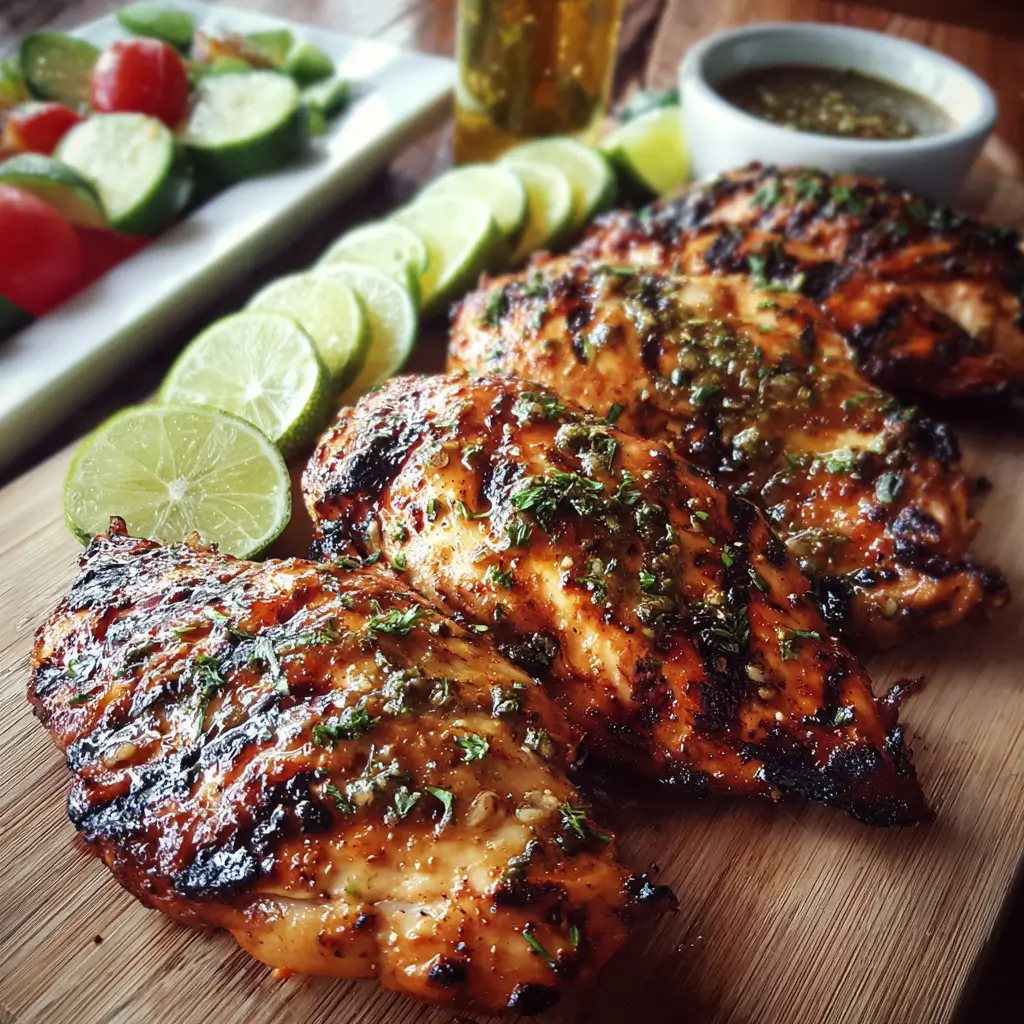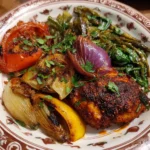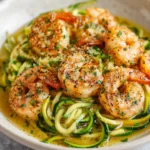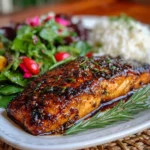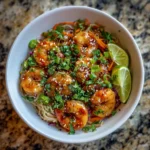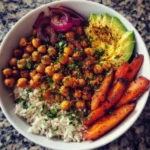Honey Lime Grilled Chicken: A Zesty, Sweet Delight for Every Palate
There’s something irresistibly satisfying about the sizzle of chicken hitting a hot grill, especially when it’s marinated in a luscious blend of honey and lime. Honey Lime Grilled Chicken is more than just a meal—it’s an experience that combines tangy citrus notes with the natural sweetness of honey, creating a flavor profile that dances on your taste buds. Whether you’re hosting a backyard barbecue, preparing a quick weeknight dinner, or looking to add some zest to your meal prep routine, this dish delivers bold flavors with minimal effort. It’s versatile, healthy, and loved by adults and kids alike.
The History of Honey Lime Grilled Chicken
While there isn’t a single documented origin for Honey Lime Grilled Chicken, its roots can be traced back to the fusion of global culinary traditions. The use of honey as a natural sweetener in cooking dates back thousands of years across various cultures—from ancient Egypt to traditional Chinese medicine practices—where it was valued not only for its flavor but also for its preservative and healing properties. Limes, native to Southeast Asia, have long been used in tropical cuisines for their bright acidity and ability to enhance savory dishes.
Grilling meat over open flames is one of humanity’s oldest cooking methods, practiced across civilizations from the indigenous peoples of the Americas to African tribes and Mediterranean societies. The modern iteration of Honey Lime Grilled Chicken likely emerged in the 20th century as home cooks began experimenting with marinades that balanced sweet, sour, and savory elements. American Southern cuisine, Caribbean grilling techniques, and South Asian spice traditions all contributed to the development of this now-classic recipe.
In recent decades, with the rise of health-conscious eating and interest in clean-label ingredients, Honey Lime Grilled Chicken gained popularity due to its reliance on whole-food components and absence of artificial additives. Today, it stands as a staple in cookbooks, food blogs, and family kitchens worldwide—a testament to its universal appeal and timeless flavor combination.
Ingredients Breakdown: What Makes This Dish Shine?
The magic of Honey Lime Grilled Chicken lies in its simple yet thoughtfully chosen ingredients. Each component plays a critical role in building layers of flavor, texture, and aroma:
- Chicken (boneless, skinless breasts or thighs): Lean protein that absorbs marinade beautifully. Thighs offer more moisture and richness; breasts are lighter and lower in fat.
- Fresh lime juice: Provides a vibrant, tart acidity that cuts through the richness of the honey and tenderizes the chicken.
- Lime zest: Adds intense citrus fragrance without extra liquid, enhancing the overall aroma.
- Honey (raw preferred): Natural sweetness that caramelizes on the grill, forming a glossy glaze. Raw honey also contributes subtle floral notes.
- Olive oil: Helps emulsify the marinade, keeps the chicken moist during grilling, and aids in even browning.
- Garlic (minced or pressed): Imparts depth and pungency, balancing the sweetness of the honey.
- Fresh ginger (grated): Adds warmth and a slight spiciness, complementing both honey and lime.
- Soy sauce or tamari: Introduces umami and saltiness, crucial for rounding out the flavors. Use low-sodium if desired.
- Black pepper (freshly ground): Offers mild heat and complexity.
- Red pepper flakes (optional): For those who enjoy a hint of spice.
- Green onions or cilantro (for garnish): Fresh herbs elevate the presentation and add a crisp, herbal finish.
Optional additions include pineapple juice (for added sweetness and enzymes), mustard (to stabilize the emulsion), or sesame oil (for an Asian-inspired twist).
Step-by-Step Recipe: How to Make Perfect Honey Lime Grilled Chicken
Follow these detailed steps to achieve juicy, flavorful, and perfectly grilled Honey Lime Chicken every time.
Preparation Time:
15 minutes (+ 30 minutes to 2 hours marinating)
Cooking Time:
6–8 minutes per side (depending on thickness)
Servings:
4
Ingredients:
- 4 boneless, skinless chicken breasts (or 6 thighs)
- ⅓ cup fresh lime juice (about 3–4 limes)
- 1 tablespoon lime zest
- ¼ cup raw honey
- 3 tablespoons olive oil
- 3 cloves garlic, minced
- 1 tablespoon fresh ginger, grated
- 2 tablespoons soy sauce (or tamari for gluten-free)
- ½ teaspoon freshly ground black pepper
- ¼ teaspoon red pepper flakes (optional)
- 2 green onions, sliced (for garnish)
- ¼ cup chopped fresh cilantro (optional)
Directions:
- Prepare the Chicken: If using chicken breasts, pound them to an even thickness (about ¾ inch) to ensure uniform cooking. Trim excess fat and pat dry with paper towels.
- Make the Marinade: In a medium bowl, whisk together lime juice, lime zest, honey, olive oil, minced garlic, grated ginger, soy sauce, black pepper, and red pepper flakes (if using). Stir until the honey is fully incorporated and the mixture is smooth.
- Marinate the Chicken: Place the chicken in a resealable plastic bag or shallow glass dish. Pour the marinade over the chicken, ensuring each piece is well-coated. Seal or cover and refrigerate for at least 30 minutes—but ideally 1 to 2 hours—for optimal flavor. Do not marinate longer than 4 hours, as the acidity from the lime can begin to “cook” the chicken and alter its texture.
- Preheat the Grill: Preheat your grill to medium-high heat (375°F to 400°F). Clean the grates thoroughly and lightly oil them to prevent sticking. Alternatively, use a grill pan indoors over the stove.
- Remove Chicken from Marinade: Take the chicken out of the refrigerator 15–20 minutes before grilling to bring it closer to room temperature. This promotes even cooking. Discard the used marinade—do not reuse it.
- Grill the Chicken: Place the chicken on the preheated grill. Cook for 6–8 minutes per side, depending on thickness, until the internal temperature reaches 165°F (74°C) when measured with a meat thermometer inserted into the thickest part.
- Baste (Optional): During the last 2–3 minutes of grilling, brush the chicken with a little extra honey-lime glaze (prepare a small batch separately for basting to avoid cross-contamination) to create a sticky, caramelized crust.
- Rest the Chicken: Once cooked, transfer the chicken to a clean plate and let it rest for 5 minutes. This allows the juices to redistribute, keeping the meat moist and tender.
- Garnish and Serve: Slice the chicken against the grain if desired, and garnish with fresh green onions and cilantro. Serve immediately.
Tips for the Best Honey Lime Grilled Chicken
- Use Fresh Citrus: Bottled lime juice lacks the brightness and aromatic oils found in freshly squeezed limes. Always opt for fresh for superior flavor.
- Don’t Over-Marinate: While marinating enhances flavor, too long in acidic marinades can make chicken mushy. Stick to 30 minutes–2 hours.
- Control Grill Heat: Too high heat will burn the honey before the chicken cooks through. Medium-high is ideal. If flare-ups occur, move chicken to indirect heat.
- Avoid Cross-Contamination: Never reuse marinade that has touched raw chicken. If you want to use it as a sauce, set aside a portion before adding chicken or boil the used marinade for 3+ minutes.
- Check Internal Temperature: Rely on a meat thermometer rather than appearance. Chicken should reach 165°F internally.
- Add Wood Chips for Smoky Flavor: Soak hickory, applewood, or mesquite chips and place them on charcoal or in a smoker box for gas grills to infuse a smoky dimension.
- Let It Rest: Skipping the resting phase causes juices to spill out when cut, resulting in drier meat.
- Try Skewers: Cut chicken into cubes and thread onto skewers for kebabs. Grill alongside bell peppers, onions, and pineapple for a complete package.
Variations and Customizations
Honey Lime Grilled Chicken is incredibly adaptable. Here are creative ways to personalize it:
- Tropical Twist: Add ¼ cup pineapple or orange juice to the marinade and serve with mango salsa.
- Asian Fusion: Replace soy sauce with teriyaki sauce, add 1 tsp sesame oil, and garnish with toasted sesame seeds.
- Spicy Version: Increase red pepper flakes to ½ tsp or add 1 finely chopped jalapeño or sriracha to the marinade.
- Herb-Infused: Mix in fresh rosemary, thyme, or basil for a garden-fresh variation.
- Dairy-Free & Paleo-Friendly: This recipe is naturally dairy-free and easily fits paleo diets when using coconut aminos instead of soy sauce.
- Meal Prep Friendly: Cook a large batch and slice for salads, wraps, rice bowls, or tacos throughout the week.
- Kid-Friendly: Reduce spices and serve with grilled corn and sweet potato fries.
- Vegan Option: Substitute chicken with firm tofu or tempeh, pressing tofu first to remove excess water for better absorption.
Health Considerations and Nutritional Value
Honey Lime Grilled Chicken is not only delicious but also nutritionally balanced when prepared mindfully.
Nutritional Highlights (per serving, approx. 6 oz grilled chicken breast):
- Calories: ~280–320 kcal
- Protein: ~35–40g (excellent source for muscle repair and satiety)
- Fat: ~9–12g (mostly heart-healthy monounsaturated fats from olive oil)
- Carbohydrates: ~15–18g (primarily from honey; natural sugars)
- Sodium: ~500–700mg (lower if using low-sodium soy sauce)
- Vitamin C: From lime juice—supports immune function and collagen production.
- Antioxidants: Honey and garlic contain compounds with anti-inflammatory properties.
Health Notes:
- Honey: While natural, honey is still a sugar. Diabetics or those monitoring blood glucose should consume in moderation. Consider reducing honey to 2 tbsp or substituting with monk fruit syrup for a low-glycemic version.
- Grilling Tips: Charring meat excessively can produce harmful compounds like heterocyclic amines (HCAs). To reduce risk, avoid burning, flip frequently, and marinate—studies show acidic marinades can reduce HCA formation by up to 90%.
- Sodium Control: Use reduced-sodium soy sauce or coconut aminos to lower salt content.
- Balanced Meal Pairing: Serve with quinoa, brown rice, roasted vegetables, or a fresh salad to boost fiber and micronutrient intake.
Frequently Asked Questions (FAQ)
Can I bake Honey Lime Grilled Chicken instead of grilling?
Yes! Preheat oven to 375°F. Place marinated chicken on a lined baking sheet and bake for 20–25 minutes, basting halfway through. Broil for 2–3 minutes at the end for caramelization.
Can I freeze marinated chicken?
Absolutely. Place chicken and marinade in a freezer-safe bag and freeze for up to 3 months. Thaw overnight in the fridge before cooking.
Why did my chicken turn out dry?
Overcooking is the most common cause. Use a thermometer and remove chicken at 160°F—it will carryover cook to 165°F while resting. Also, avoid skipping the resting step.
Can I use bottled lime juice?
Fresh is best, but in a pinch, use 100% pure lime juice without preservatives. Avoid mixes with added sugars or sulfites.
Is this recipe gluten-free?
Yes, if you use tamari or coconut aminos instead of regular soy sauce.
How long does leftover chicken last?
Store in an airtight container in the fridge for up to 4 days. Reheat gently in a skillet or microwave.
Can I use this marinade for other proteins?
Definitely! Works wonderfully with shrimp, salmon, pork chops, or tofu.
Summary
Honey Lime Grilled Chicken blends the natural sweetness of honey with the zesty kick of fresh lime, creating a harmonious, mouthwatering dish perfect for any occasion. Packed with flavor, easy to customize, and rich in lean protein, it’s a healthy, crowd-pleasing favorite that shines on the grill and beyond.
